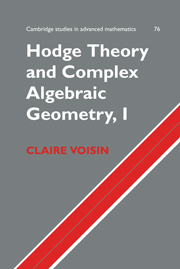0 - Introduction
Published online by Cambridge University Press: 21 January 2010
Summary
Kähler manifolds and projective manifolds. The goal of this first volume is to explain the existence of special structures on the cohomology of Kähler manifolds, namely, the Hodge decomposition and the Lefschetz decomposition, and to discuss their basic properties and consequences. The second volume will be devoted to the systematic application of these results in different directions, relating Hodge theory, topology and the study of algebraic cycles on smooth projective complex manifolds.
Indeed, smooth projective complex manifolds are special cases of compact Kähler manifolds. A Kähler manifold is a complex manifold equipped with a Hermitian metric whose imaginary part, which is a 2-form of type (1, 1) relative to the complex structure, is closed. This 2-form is called the Kähler form of the Kähler metric. As complex projective space (equipped, for example, with the Fubini–Study metric) is a Kähler manifold, the complex submanifolds of projective space equipped with the induced metric are also Kähler. We can indicate precisely which members of the set of Kähler manifolds are complex projective, thanks to Kodaira's theorem:
Theorem 0.1A compact complex manifold admits a holomorphic embedding into complex projective space if and only if it admits a Kähler metric whose Kähler form is of integral class.
In this volume, we are essentially interested in the class of Kähler manifolds, without particularly emphasising projective manifolds. The reason is that our goal here is to establish the existence of the Hodge decomposition and the Lefschetz decomposition on the cohomology of such a manifold, and for this, there is no need to assume that the Kähler class is integral.
Information
- Type
- Chapter
- Information
- Hodge Theory and Complex Algebraic Geometry I , pp. 1 - 18Publisher: Cambridge University PressPrint publication year: 2002
